For quick privacy fence coverage, consider these standout climbers: Boston Ivy with its stunning fall colors, fragrant Honeysuckle that attracts pollinators, versatile Clematis with 300+ varieties, dramatic Trumpet Vine for hummingbirds, cheerful Black-Eyed Susan Vine, drought-tolerant Bougainvillea with vibrant cascading blooms, and evergreen English Ivy for year-round screening. Each option offers unique benefits beyond just coverage, transforming your ordinary fence into a living privacy solution.
Boston Ivy: The Fast-Growing Privacy Solution
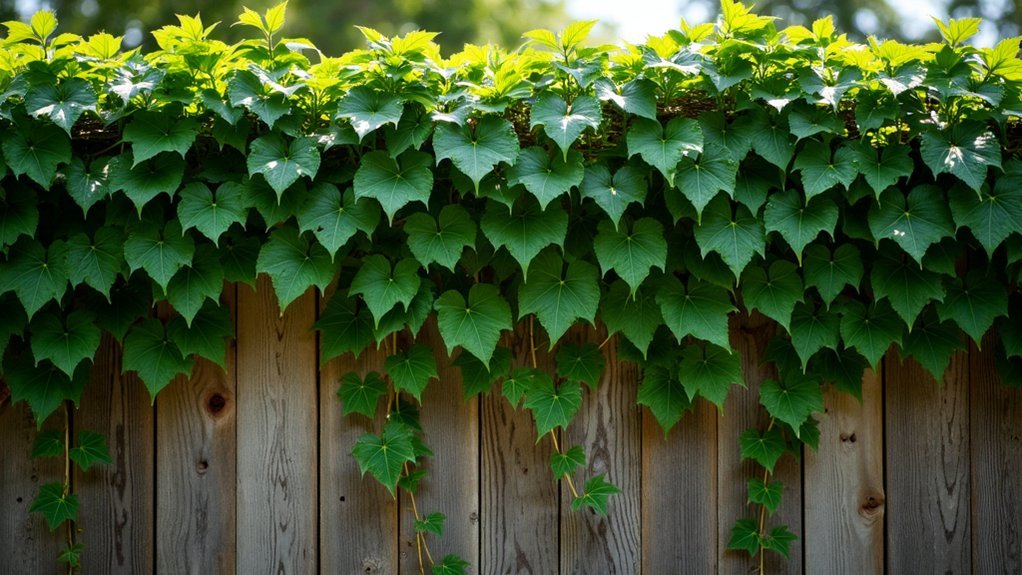
A verdant curtain of foliage, Boston Ivy offers an exceptional solution for homeowners seeking quick privacy. This woody vine reaches up to 60 feet in length, rapidly covering fences with its broad, glossy leaves measuring 4-8 inches wide.
You’ll appreciate how Boston Ivy attaches firmly to surfaces using adhesive discs rather than invasive root systems, requiring no additional support systems. It thrives in USDA zones 4-8 and adapts to poor soil conditions, making it suitable for challenging locations.
In autumn, the deep green leaves transform into stunning scarlet and orange-red hues, adding seasonal interest while maintaining coverage well into fall.
Though semi-deciduous in warmer regions, it’s deer-resistant and needs minimal maintenance once established. Just be aware of its potential invasiveness in some areas—a small trade-off for its impressive privacy benefits.
Clematis: Decorative Flowering Coverage for Your Fence
Renowned for their spectacular blooms and versatile growing habits, clematis vines offer both privacy and beauty when grown along fences. With over 300 cultivars available, you’ll find options for every garden style and climate zone. These beautiful vines are available in evergreen or deciduous forms to suit your specific privacy needs.
| Variety | Features | Growth Rate | Best Use |
|---|---|---|---|
| *Clematis armandii* | Evergreen, fragrant white flowers | 10-15 ft/season | Year-round screening |
| *Clematis montana* | Vigorous, reaches 20-30 ft | Rapid | Quick coverage |
| Large-flowered hybrids | Showy blooms in various colors | Moderate | Decorative privacy |
| Group 3 clematis | Hard prune in late winter | Vigorous regrowth | Low-maintenance options |
Plant clematis 2-3 feet apart along your fence line. They’ll achieve partial coverage within 1-2 seasons and full privacy within 2-3 years. Remember to shade their roots while giving foliage plenty of sun.
Honeysuckle: Fragrant and Wildlife-Friendly Screening
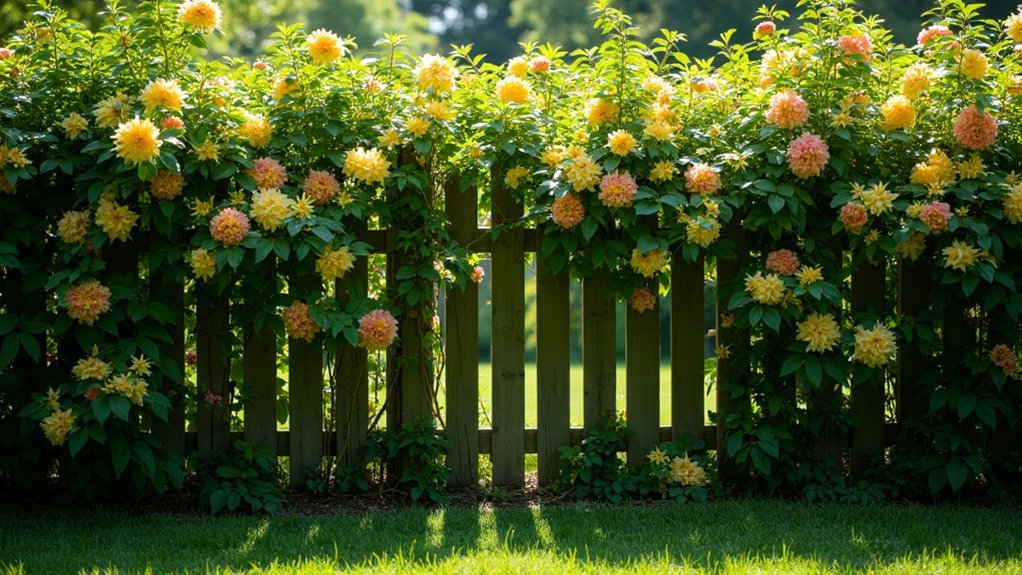
Honeysuckle’s sweet fragrance won’t just delight your senses but will attract bees, butterflies, and other beneficial pollinators to your garden.
You’ll appreciate how quickly this vigorous climber establishes itself on your fence, providing a dense privacy screen in just a few growing seasons. For best results, avoid overwatering your vines as this common mistake can significantly slow growth and reduce flowering.
The colorful blooms create a stunning visual display against your fence while serving as both a beautiful barrier and wildlife habitat.
Scent Attracts Beneficial Pollinators
The intoxicating fragrance of honeysuckle does more than just delight your senses—it’s a powerful attractant for beneficial pollinators essential to your garden’s ecosystem.
As these vines bloom, they draw in a diverse array of pollinators including bees, butterflies, and hummingbirds.
You’ll notice peak pollinator activity during flowering seasons, with many species visiting at night when honeysuckle’s scent intensifies.
This nocturnal fragrance evolution specifically targets moths and other evening pollinators.
The plant’s tube-shaped flowers contain sweet nectar that rewards these visitors while ensuring pollination occurs. The coral honeysuckle variety with its red tubular flowers is particularly effective at attracting hummingbirds and butterflies to your privacy fence.
Fast-Growing Privacy Solution
When seeking rapid privacy solutions for your yard, few plants match honeysuckle’s impressive growth rate and natural screening capabilities.
With proper support systems like trellises or wire frames spaced 18 inches apart, you’ll create an ideal framework for these vigorous climbers. Arranging the supports in a diamond pattern creates an aesthetically pleasing display while maximizing coverage.
Plant honeysuckle in sunny locations, especially along south-facing walls, to maximize growth. After planting, cut back shoots by two-thirds to encourage robust stem development.
You’ll need to water thoroughly during the first year and apply mulch to retain moisture.
For year-round screening, choose Lonicera japonica (evergreen), or mix with deciduous varieties like Lonicera periclymenum for seasonal interest.
Train your honeysuckle through lattice or chain-link fencing for a natural screen that attracts wildlife.
Regular pruning keeps growth controlled while stimulating new foliage for denser coverage.
Colorful Fence Coverage
Transforming your fence into a vibrant living screen, honeysuckle offers an explosion of color alongside its practical privacy benefits.
Varieties like ‘Serotina’ showcase stunning purple-red buds that open to cream-yellow blooms, while ‘Graham Thomas’ delivers soft lemon-yellow flowers that gradually fade to white.
You’ll enjoy the sweet, heady fragrance that intensifies in the evening, perfuming a 3-5m radius around your fence line.
This aromatic display isn’t just for you—it supports essential wildlife in your garden.
Plant in dappled shade for optimal growth and flowering, as excessive shade reduces blooms while direct sunlight can scorch delicate leaves.
For maximum visual impact:
- Choose bi-color varieties for dramatic contrast
- Incorporate variegated Artensiensis for year-round interest
- Plant Dropmore Scarlet for vibrant red-orange blooms
- Add ‘Winter Beauty’ for off-season white flowers
Bougainvillea: Vibrant Color for Warm-Climate Privacy
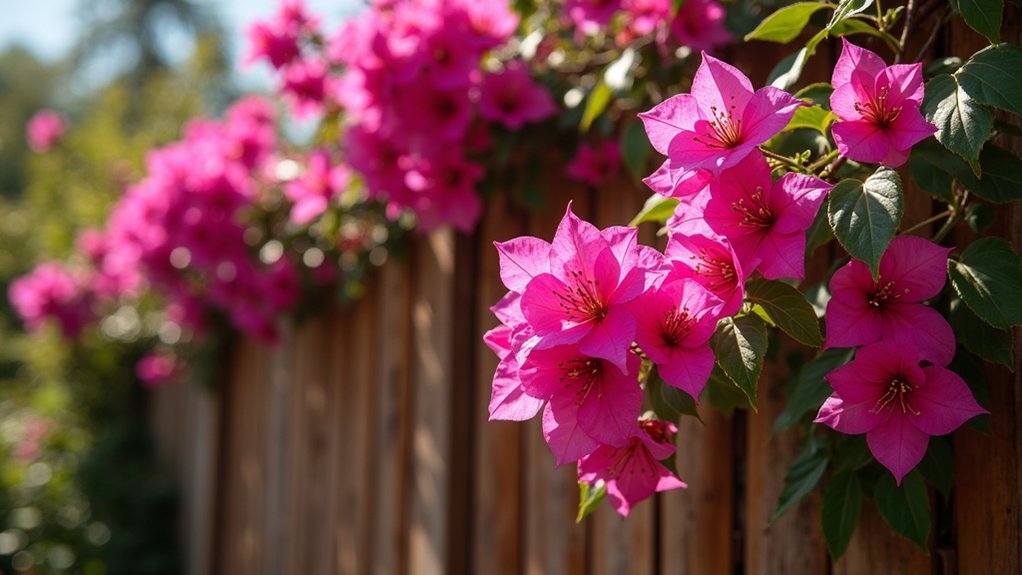
Bougainvillea’s cascading curtain of vibrant blooms in gold, purple, or orange creates an eye-catching privacy screen while its thorny stems provide an effective security deterrent against intruders.
You’ll appreciate how this drought-tolerant climber thrives with minimal watering in USDA zones 10-11, reaching heights up to 30 feet when properly supported. Originally discovered by French explorer Bougainville, this versatile plant has become a popular choice for security-conscious homeowners.
Train young vines along your fence using soft ties and strategic pruning to develop dense coverage, ensuring both the spectacular visual impact and practical screening benefits you’re seeking.
Spectacular Color Displays
Few plants deliver the dramatic visual impact of bougainvillea when privacy and color are your primary objectives. The vibrant bracts offer long-lasting color compared to true flowers, making them perfect for fence coverage in zones 9-11.
Purple Queen® creates a rich purple backdrop against green foliage, while Camarillo Fiesta® brings exciting hot pink and gold combinations to your landscape. For secure coverage, ensure your fence is sturdy and stable as the mature weight of these woody vines can be substantial.
For maximum color impact with bougainvillea:
- Plant in full sun (6+ hours daily) to guarantee vibrant bract development
- Create striking contrasts by pairing Orange King with Purple Queen® varieties
- Space plants 5-10 feet apart for proper air circulation and growth
- Apply phosphorus-rich fertilizer to enhance bloom production throughout the growing season
Drought-Tolerant Security Screen
Beyond their spectacular colors, bougainvilleas serve as exceptional drought-tolerant security screens for privacy fences. Their dense, thorny growth creates a natural barrier that discourages unwanted access while thriving in USDA zones 9-11.
You’ll appreciate how quickly bougainvillea establishes coverage, with woody stems and self-clinging tendrils firmly attaching to various fence materials. The plant requires minimal water once established, making it perfect for xeriscaping and sustainable landscapes. Bougainvillea, with its native origins in Brazil, creates a stunning tropical atmosphere while providing privacy.
For ideal security screening, plant bougainvillea in full sun with well-drained soil. Prune after flowering cycles to promote denser growth. The deep root system enhances drought resilience while supporting the extensive above-ground coverage you need for privacy.
This versatile climber not only secures your space but also blocks wind, dust, and noise while supporting local pollinators.
Training For Maximum Coverage
To achieve a spectacular privacy screen with bougainvillea, you’ll need to implement specific training techniques that maximize coverage across your fence line.
Begin by installing a heavy-duty support system—chain-link fencing or metal frameworks work best, while avoiding decorative materials that can’t handle vigorous growth.
During the training phase, remove flower buds to prioritize vegetation and tie main stems using nylon strips. Guide lateral branches horizontally and reposition regularly for even coverage. When tying the plant to your support structure, you can use twine for attachment as an inexpensive and effective option.
For ideal results:
- Maintain 6-8 primary vines as your framework scaffolding
- Pinch tips to stimulate lateral branching
- Cut back vigorously near the support base for density
- Position in full sunlight (6+ hours daily)
Don’t overwater and verify well-draining soil to prevent root rot while establishing your privacy screen.
Trumpet Vine: Dramatic, Hummingbird-Attracting Coverage
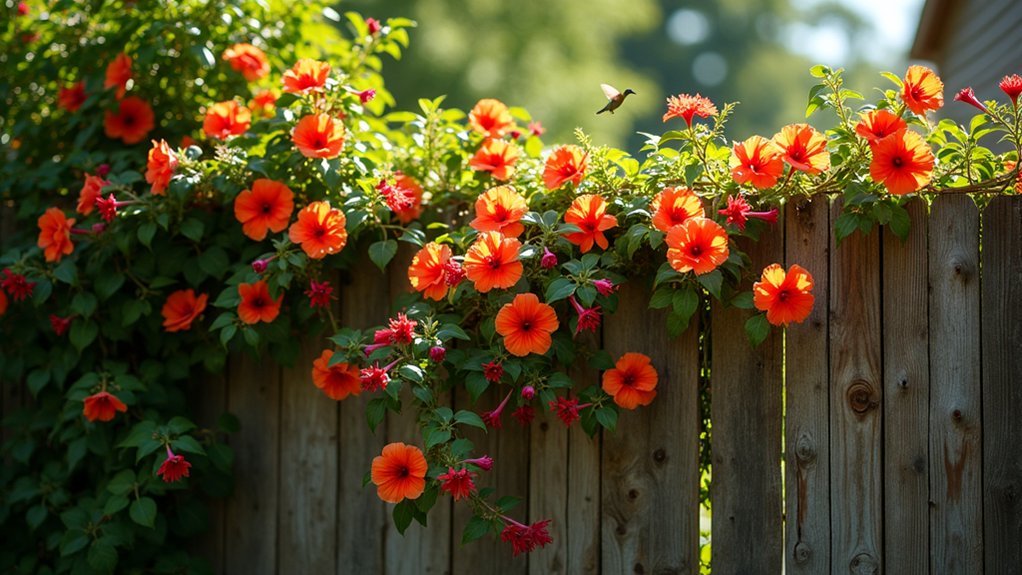
Dramatically transforming any privacy fence into a vibrant wildlife sanctuary, Trumpet Vine (Campsis radicans) combines spectacular flowering with aggressive coverage capabilities. You’ll enjoy 3.5″ trumpet-shaped blooms in vibrant red-orange from June through September, creating a hummingbird haven in your yard. Native to eastern North America, this woody vine thrives in various soil conditions and locations.
| Feature | Benefit | Consideration |
|---|---|---|
| 30-40′ growth | Complete fence coverage | Requires sturdy support |
| Rapid spread | Quick privacy solution | Annual aggressive pruning needed |
| Hummingbird magnet | Wildlife attraction | Avoid wood fences (rootlet damage) |
| Drought tolerant | Low maintenance | Can colonize beyond intended area |
| Long bloom period | Months of color | Best for dedicated structures |
While trumpet vine provides exceptional coverage and wildlife value, you’ll need to commit to regular maintenance to prevent it from overwhelming your landscape.
Black-Eyed Susan Vine: Cheerful, Easy-Care Fence Disguise
For gardeners seeking a less aggressive but equally charming privacy solution, Black-Eyed Susan Vine (Thunbergia alata) offers the perfect balance of beauty and manageability.
This fast-growing annual vine quickly reaches 5-8 feet tall while spreading up to 2 feet wide, making it ideal for disguising privacy fences.
Native to Africa and Madagascar, this twining climber thrives in zones 10-11 with its heart-shaped, dark green leaves providing a lush backdrop for its colorful blooms. The vine attracts butterflies and hummingbirds to your garden, adding wildlife interest to your privacy screen.
Bringing African garden magic to your fence with lush, heart-shaped foliage and vibrant flowers perfect for warmer climates.
What makes Black-Eyed Susan Vine perfect for your fence:
- Self-cleaning flowers in orange, yellow, pink, red, or white appear from midsummer to early fall
- Adapts to both full sun and partial shade conditions
- Works beautifully in containers placed along fence lines
- Requires minimal maintenance beyond providing climbing support
English Ivy: Year-Round Evergreen Seclusion
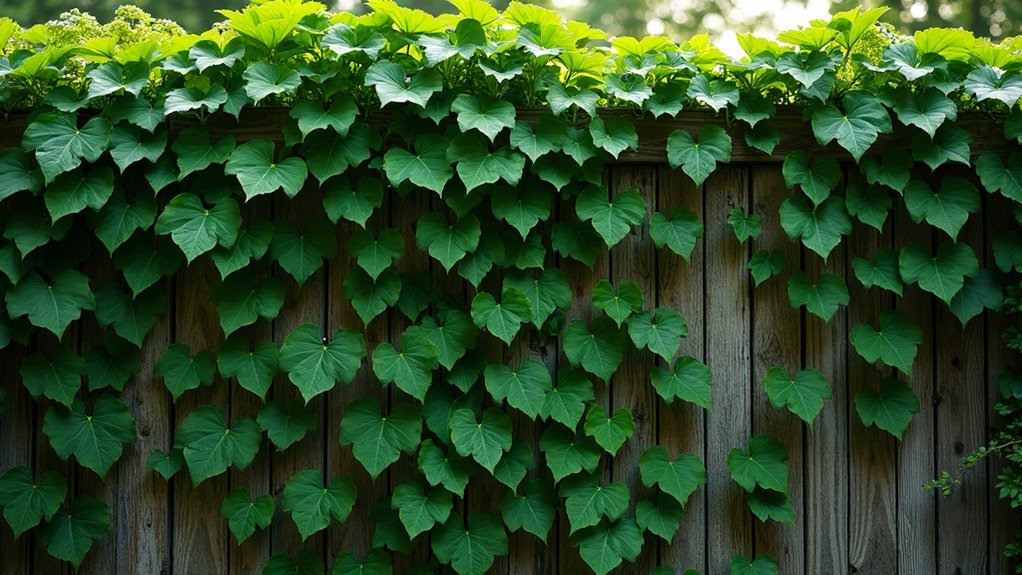
English Ivy (Hedera helix) stands as the quintessential fence-covering plant, offering year-round privacy with its dense, evergreen foliage.
You’ll appreciate its remarkable speed – capable of covering an entire fence in just one year under ideal conditions.
This versatile climber thrives in both sunny and shaded locations, making it perfect for challenging spaces where other plants struggle. For optimal growth, prepare the soil by adding plenty of compost to improve fertility and moisture retention.
It’s particularly effective on chain link fences and provides an inexpensive privacy solution compared to wooden panels.
However, be prepared for regular maintenance.
English Ivy’s vigorous nature requires consistent pruning to prevent it from becoming invasive or damaging nearby structures.
Its underground rooting system can spread beyond intended boundaries if left unchecked.
Consider alternatives like Boston Ivy or Passiflora if you’re concerned about its potentially invasive qualities.
Frequently Asked Questions
How Do Climbing Plants Affect Fence Stability and Longevity?
Climbing plants can impact your fence’s stability by adding weight and trapping moisture, potentially causing decay. However, they’ll also protect it from weather elements if you maintain them with regular pruning.
Can These Vines Damage Neighboring Property When Planted Along Boundaries?
Yes, your boundary vines can damage neighboring property. They may grow onto structures, cause moisture damage, or become invasive. You’ll need to maintain them regularly and consider legal implications of cross-boundary growth.
Which Climbing Plants Are Pet and Child-Safe?
For pet and child-safe climbing plants, you’ll want to choose Climbing Begonia, Grape Ivy, Hoya obovata, Crossvine, Coral honeysuckle, Beetle peperomia, Nasturtium, Black-eyed Susan vine, Passionflower, and Virginia creeper. Avoid pothos and Devil’s Ivy completely.
How Do Climbing Plants Perform in Extreme Weather Conditions?
Many climbing plants thrive in extreme weather. You’ll find options like climbing roses for cold areas, bougainvillea for heat, and ivy for both. They’ll provide natural insulation while withstanding harsh conditions year-round.
What Alternatives Exist for Rental Properties With Fence Modification Restrictions?
You can use portable planters with freestanding trellises, hanging baskets, or modular green wall panels. Try container-trained dwarf trees, potted grasses, or lightweight climbers on tension rod systems for privacy without fence modifications.
In Summary
With these 7 climbing plants, you’ll transform your plain fence into a lush, living privacy screen. Whether you’re seeking fast growth, colorful blooms, wildlife benefits, or year-round coverage, there’s a perfect climber for your needs. Don’t wait to create your secluded outdoor sanctuary—choose the variety that matches your climate and preferences, and you’ll enjoy the natural privacy they provide for years to come.

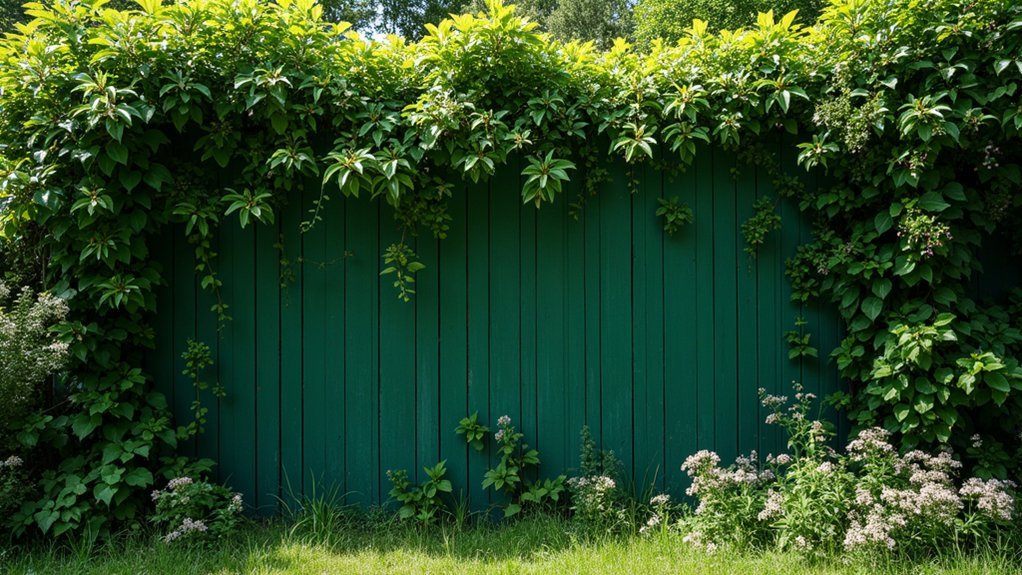



Leave a Reply